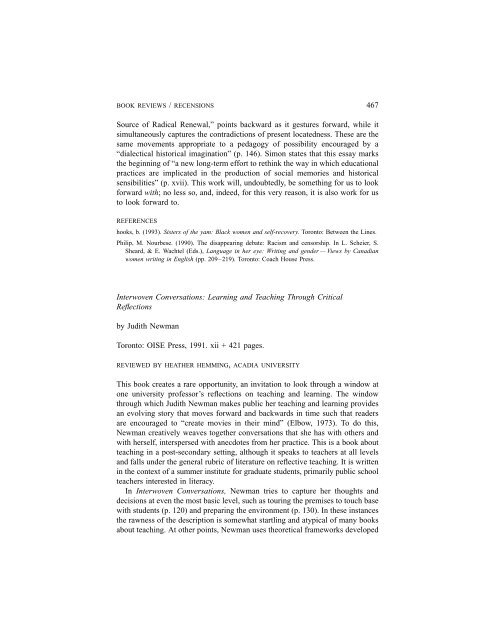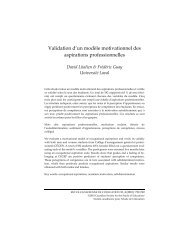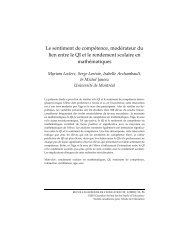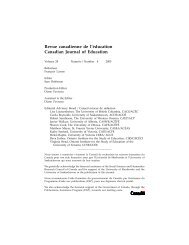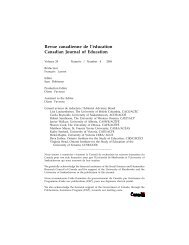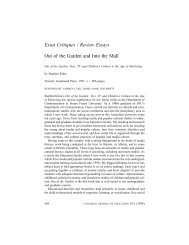Mireille Falardeau et Michel Loranger Le choix de stratégies ... - CSSE
Mireille Falardeau et Michel Loranger Le choix de stratégies ... - CSSE
Mireille Falardeau et Michel Loranger Le choix de stratégies ... - CSSE
You also want an ePaper? Increase the reach of your titles
YUMPU automatically turns print PDFs into web optimized ePapers that Google loves.
BOOK REVIEWS / RECENSIONS 467<br />
Source of Radical Renewal,” points backward as it gestures forward, while it<br />
simultaneously captures the contradictions of present locatedness. These are the<br />
same movements appropriate to a pedagogy of possibility encouraged by a<br />
“dialectical historical imagination” (p. 146). Simon states that this essay marks<br />
the beginning of “a new long-term effort to r<strong>et</strong>hink the way in which educational<br />
practices are implicated in the production of social memories and historical<br />
sensibilities” (p. xvii). This work will, undoubtedly, be som<strong>et</strong>hing for us to look<br />
forward with; no less so, and, in<strong>de</strong>ed, for this very reason, it is also work for us<br />
to look forward to.<br />
REFERENCES<br />
hooks, b. (1993). Sisters of the yam: Black women and self-recovery. Toronto: B<strong>et</strong>ween the Lines.<br />
Philip, M. Nourbese. (1990). The disappearing <strong>de</strong>bate: Racism and censorship. In L. Scheier, S.<br />
Sheard, & E. Wachtel (Eds.), Language in her eye: Writing and gen<strong>de</strong>r — Views by Canadian<br />
women writing in English (pp. 209–219). Toronto: Coach House Press.<br />
Interwoven Conversations: <strong>Le</strong>arning and Teaching Through Critical<br />
Reflections<br />
by Judith Newman<br />
Toronto: OISE Press, 1991. xii + 421 pages.<br />
REVIEWED BY HEATHER HEMMING, ACADIA UNIVERSITY<br />
This book creates a rare opportunity, an invitation to look through a window at<br />
one university professor’s reflections on teaching and learning. The window<br />
through which Judith Newman makes public her teaching and learning provi<strong>de</strong>s<br />
an evolving story that moves forward and backwards in time such that rea<strong>de</strong>rs<br />
are encouraged to “create movies in their mind” (Elbow, 1973). To do this,<br />
Newman creatively weaves tog<strong>et</strong>her conversations that she has with others and<br />
with herself, interspersed with anecdotes from her practice. This is a book about<br />
teaching in a post-secondary s<strong>et</strong>ting, although it speaks to teachers at all levels<br />
and falls un<strong>de</strong>r the general rubric of literature on reflective teaching. It is written<br />
in the context of a summer institute for graduate stu<strong>de</strong>nts, primarily public school<br />
teachers interested in literacy.<br />
In Interwoven Conversations, Newman tries to capture her thoughts and<br />
<strong>de</strong>cisions at even the most basic level, such as touring the premises to touch base<br />
with stu<strong>de</strong>nts (p. 120) and preparing the environment (p. 130). In these instances<br />
the rawness of the <strong>de</strong>scription is somewhat startling and atypical of many books<br />
about teaching. At other points, Newman uses theor<strong>et</strong>ical frameworks <strong>de</strong>veloped


